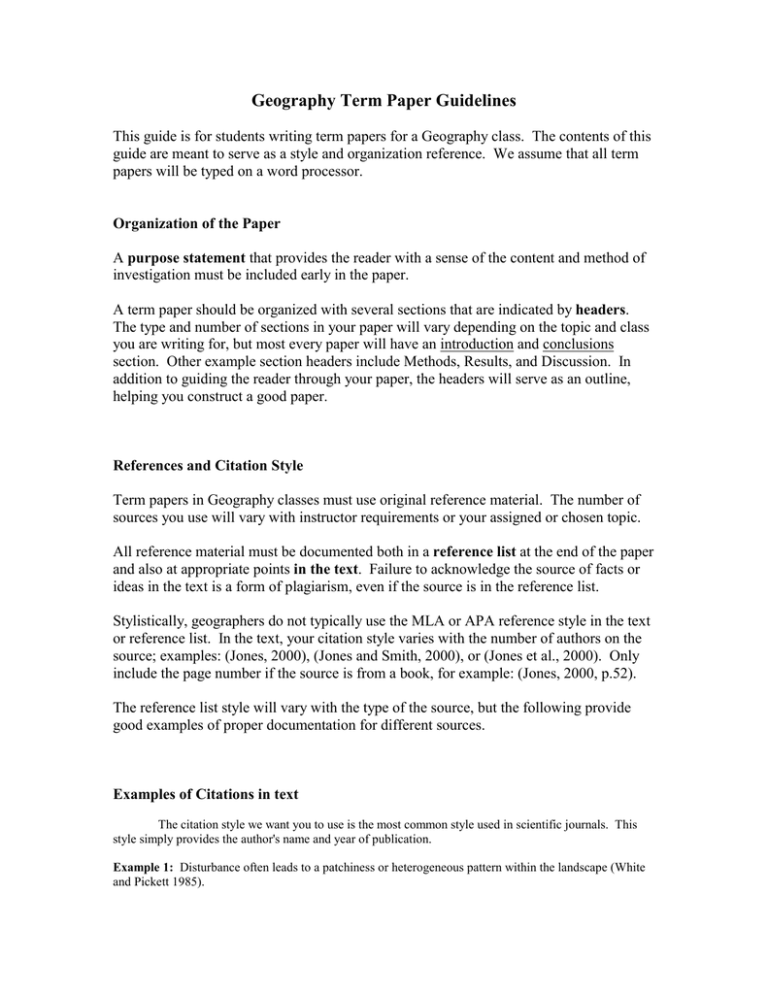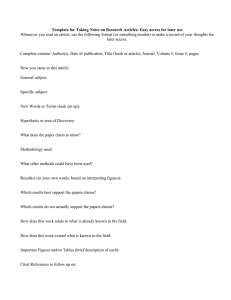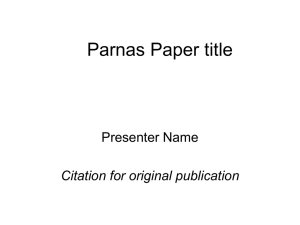Geography Term Paper Guidelines
advertisement

Geography Term Paper Guidelines This guide is for students writing term papers for a Geography class. The contents of this guide are meant to serve as a style and organization reference. We assume that all term papers will be typed on a word processor. Organization of the Paper A purpose statement that provides the reader with a sense of the content and method of investigation must be included early in the paper. A term paper should be organized with several sections that are indicated by headers. The type and number of sections in your paper will vary depending on the topic and class you are writing for, but most every paper will have an introduction and conclusions section. Other example section headers include Methods, Results, and Discussion. In addition to guiding the reader through your paper, the headers will serve as an outline, helping you construct a good paper. References and Citation Style Term papers in Geography classes must use original reference material. The number of sources you use will vary with instructor requirements or your assigned or chosen topic. All reference material must be documented both in a reference list at the end of the paper and also at appropriate points in the text. Failure to acknowledge the source of facts or ideas in the text is a form of plagiarism, even if the source is in the reference list. Stylistically, geographers do not typically use the MLA or APA reference style in the text or reference list. In the text, your citation style varies with the number of authors on the source; examples: (Jones, 2000), (Jones and Smith, 2000), or (Jones et al., 2000). Only include the page number if the source is from a book, for example: (Jones, 2000, p.52). The reference list style will vary with the type of the source, but the following provide good examples of proper documentation for different sources. Examples of Citations in text The citation style we want you to use is the most common style used in scientific journals. This style simply provides the author's name and year of publication. Example 1: Disturbance often leads to a patchiness or heterogeneous pattern within the landscape (White and Pickett 1985). Example 2: According to Hadley (1990), forest susceptibility to insect attack is primarily a function of stand age and size structure. Example 3: "Disturbance is any relatively discrete event in time that disrupts ecosystem, community, or population structure and changes resources, substrate availability, or the physical environment" (White and Pickett 1985, p. 7). Note that when a quotation is used, the page number of the quote must also be given. Avoid the use of long quotes! Generally, you can paraphrase the material in longer quotes more concisely than it was originally written. In addition, long quotes require additional format changes in your paper. Example 4: Veblen et al. (1991) found that blowdown accelerated succession in the subalpine forests of Rocky Mountain National Park. In cases where there are more than two authors, the Latin "et al." ("and others") is used for brevity. Example 5: These conditions have been reported elsewhere in the literature (Veblen et al. 1990, Franklin and Spies 1991, Waring et al. 1991). Examples of reference style When multiple citations are used, they are listed first in chronological order (earliest publication first) and then in alphabetical order when two or more references are cited for the same year. Examples of References EXAMPLE 1: - Journal article (#s refer to volume and pages) Veblen, T.T., Hadley, K.S., Reid, M.S., and Rebertus, A.J. 1991. Methods of detecting past spruce beetle outbreaks in Rocky Mountain subalpine forests. Canadian Journal of Forest Research. 21: 242254. EXAMPLE 2: - Book chapter Berryman, A.A. 1982. Population dynamics of bark beetles. In: Bark beetles of North American conifers: A system for the study of evolutionary ecology. Edited by J.B. Mitton and K.B. Sturgeon. University of Texas Press, Austin. pp. 264-314. EXAMPLE 3: - Book Fritts, H.C. 1976. Tree rings and climate. Academic Press, New York. EXAMPLE 4: - Report or miscellaneous publication Furniss, M.M. and Carolin, V.M. 1980. Western forest insects. U.S. Forest Service Miscellaneous Publication No. 1339. EXAMPLE 5: - Dissertation or thesis Swetnam, T.W. 1987. A dendroecological assessment of western spruce budworm, Choristoneura occidentalis Freeman, in the southern Rocky Mountains. Ph.D. dissertation, University of Arizona, Tucson, AZ. Finding Scientific Journal Sources An excellent source of journal articles is a service called UnCover (uncweb.carl.org). This free catalog service will allow you to search a database of over 7,000,000 journal articles published since 1988 in 17,000 journals. Additionally, the Science Citation Index (http://wos.isiglobalnet.com) (which is only available if you are on campus) indexes millions of journal articles dating back to the late 1980s. Another service, EBSCOhost (http://library.uww.edu/indexes/articles.htm) can be found on the UWW library home page (library.uww.edu) and provides full-text access to articles (many of which are from popular journals, but some are scientific in nature). Generally web pages are not acceptable sources, however many government (state, federal, foreign) agencies and non-governmental organizations (e.g., United Nations) do “publish” documents on the internet. These documents will have authors (or the name of the agency), titles, dates of publication much like a journal article and should be cited appropriately. Additional Style Notes Here are a few additional guidelines that will make your paper mechanically and stylistically superior. • Include a title. All papers must have a title that effectively conveys the topic of the paper, and possibly the methods and findings. Not all papers will require a separate title page, however. Check with your instructor for preferences. • Use a 12-point font. Double line spacing unless instructed otherwise. • Use left justification. Full justification is more difficult to read. • Number pages. If a title page is used it is typically not included in the page count. • Use a space between a number and the units, for example: 25 km2 • Use superscripts and subscripts when appropriate (write CO2 not CO2). Word processing software makes using various font effects easy. • Margins should be 1”. • All tables, figures, and graphs should be numbered and referred to within the paper. If you photocopy one of these from an article or book you should renumber it so that it is in sequence with other items in your paper, and the source must be cited. • Binding. Some instructors prefer plastic covers or other binding for your paper, but others do not; check with your instructor. A single appropriately placed staple will typically suffice.

